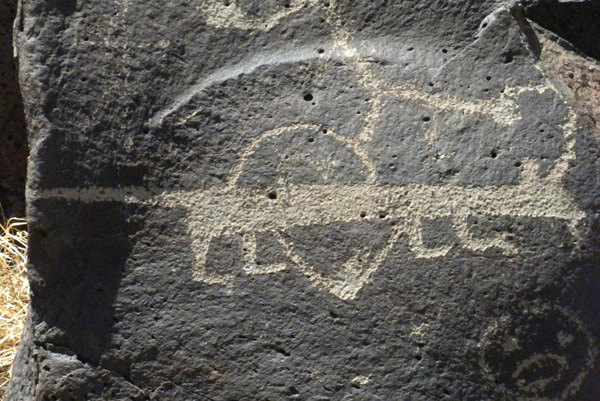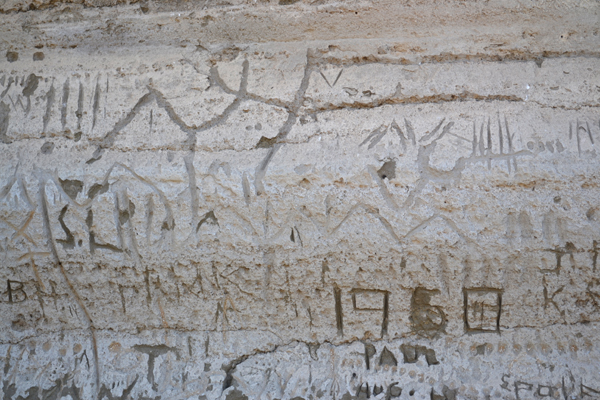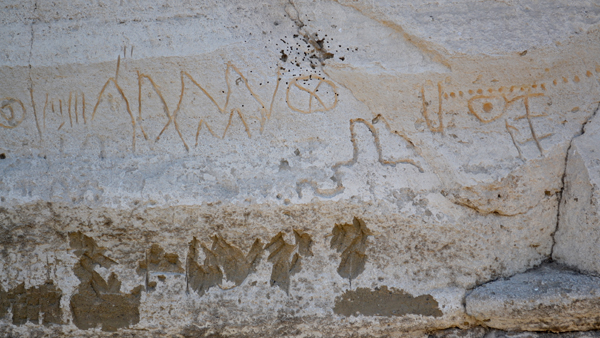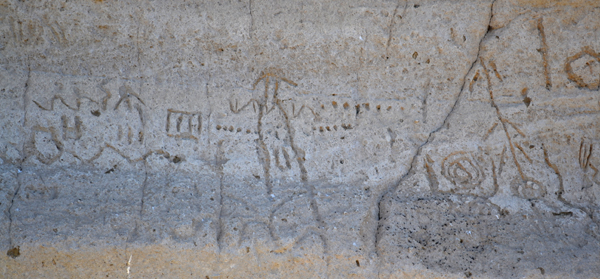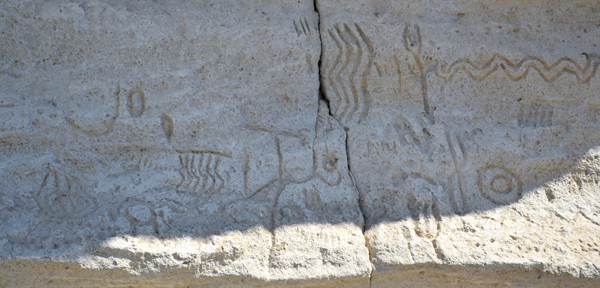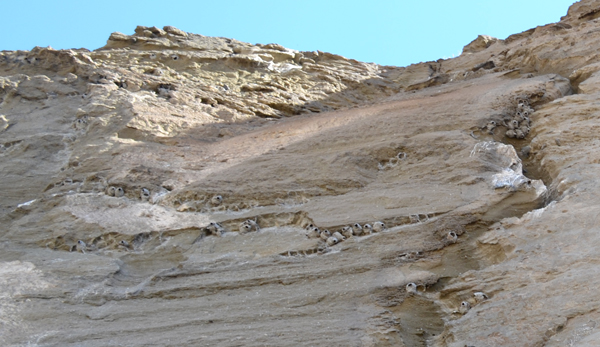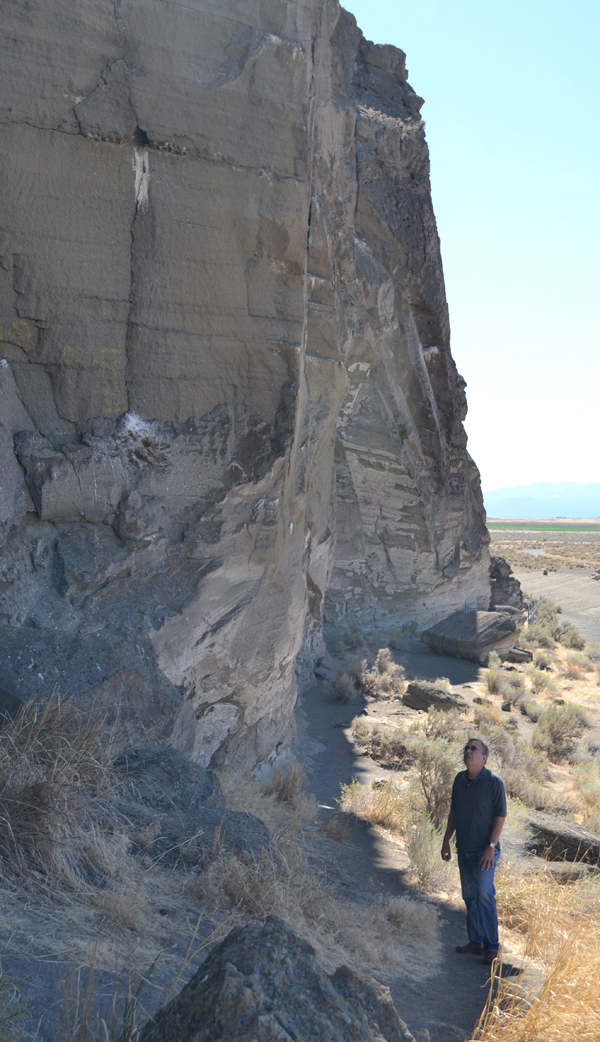Detour for Ancient Art – Petroglyphs at Lava Beds National Monument, Northern California
[separator /]On our drive from Crater Lake National Park (Oregon) to Reno (Nevada) last month, my companion Michael and I made a detour to Lava Beds National Monument. I feared we didn’t have enough time to explore the network of lava-tube caves, but when the rangers pointed out Petroglyph Point on a map, we decided to head there. I got the petroglyph bug last year during a sibling trip to New Mexico. We first saw ancient Amerind-carved rock art at Bandelier National Monument near Sante Fe. But more impressive were the images on the huge basalt boulders of Petroglyph National Monument near Albuquerque.
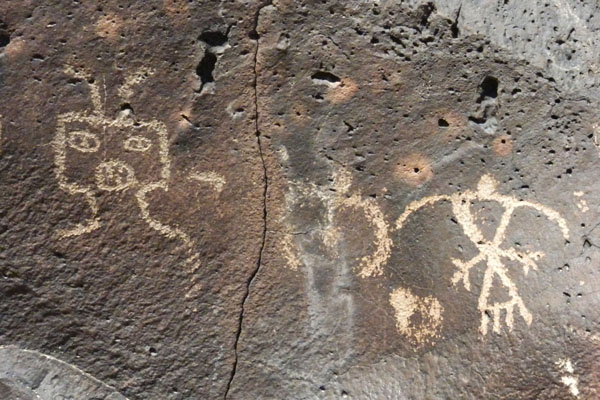
There was something about the red-tinted blackness of the lava rock and stark immediacy of the whiter petroglyph images that was truly powerful. Yes, the face on the left has a space-alien aspect to it. But the brutal rectangular head, wide-open eyes and toothed mouth is still very human. We read it today as menacing. I suspect the artist of ages ago had that in mind.
And the elongated critter on this rock may represent a common quadruped, maybe even a domesticated one. Yet it could easily have a spiritual or symbolic nature, an emblem of good luck perhaps.
So at Petroglyph Point in far northern California, I was expecting images just as stark. But disappointment was immediate even before we stopped the car. Credit that to the chain-link fence topped with barbwire that lined the base of the cliff. The fence, according to the park website, dates to the 1930s. Here’s an example of desecrated petroglyphs just beyond the fence’s protection:
And here’s a location inside the fence with later “carvings” chiseled away:
The monument’s website raises the question about the age of the images: “It is hard to determine the age of rock art. This is especially true of petroglyphs, since material was removed in their creation, not added. It is possible that some of these images at Lava Beds were made more that 6,000 years ago. Estimating the age of an individual petroglyph based on weathering is complicated by the number of times it may have been inundated in water as Tule Lake rose and fell around the island that later became known as Petroglyph Point. Interestingly, some of the geometric patterns found in the rock imagery here appear on household items up to 5,000 years old from nearby Nightfire Island. Could some of the same people have carved those same patterns into the rocks at Petroglyph Point? With over 5,000 individual carvings, this site is one of the most extensive representations of American Indian rock art in California—it is possible that dozens or even hundreds of generations of artists paddled out in canoes, sharp sticks or stones in hand, to leave their mark here in the soft volcanic tuff.”
The softness and the color of this volcanic rock did lessened the impact. The softness did allow for easier gouging but also allowed swifter erosion. Only the areas of petroglyph-covered rock protected by overhangs were still crisp. And the ease of carving, I suspect, allowed multiple carving sessions in the same areas. As the waters of Tule Lake fluctuated, different levels–sometimes overlapping levels–of the cliff face became reachable to the carvers. And the light color also made the surviving petroglyphs less dramatic. Yet here are some samples of less disturbed images.
Again I return to the website in trying to decipher meaning from the petroglyphs: “Looking at the images at Lava Beds, most visitors can’t help but imagine what such patterns might mean. Unfortunately, historic events in this area have made gathering information difficult. Before the Modoc War [winter of 1872-1873] caused tribal fracturing and the removal of the Lava Beds’ band of Modocs to Oklahoma, no ethnographic study was ever done with Modoc peoples to record their stories about images they may have been familiar with or their beliefs about images left behind by even earlier peoples. Today, it is probable that some knowledge surrounding the rock imagery of the lava beds is not shared with those on the outside.”
At least one group of artists are still at work at Petroglyph Point: cliff swallows. Their colonies of mud nests are built into indentations of the cliff face. Their work easily equals that of any environmental artist. Take a look:
And one last view to help give a scale of Petroglyph Point. Here’s Michael at the base of an area without discernable petroglyphs.
Trackback URL: https://www.scottponemone.com/detour-for-ancient-art-petroglyphs-at-lava-beds-national-monument-northern-california/trackback/

